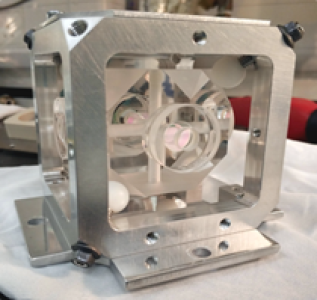Multi-wavelength clock control unit MW-CCU
Programme
GSTP
Programme Reference
GT17-203MM
Prime Contractor
NATIONAL PHYSICAL LABORATORY - NPL Management Limited
Start Date
End Date
Status
Closed
Country
United Kingdom

Objectives
The activity objectives involve the development of an integrated combination of opto-electronic control technology and optical sub-systems based on high finesse ultra-low-expansion glass optical cavities for the parallel frequency / wavelength stabilisation of multiple narrow-spectral-linewidth lasers.
Description
Multiple narrow bandwidth lasers are required for quantum sensor systems. These systems rely on specific coherent sources for laser cooling and trapping, atomic state preparation and interrogation of the cold atomic samples. There is also a parallel requirement to deliver these specific lasers (at the experiment) for predefined periods. Wavelength knowledge to a high accuracy and precision, control and/or removal of the laser frequency drift are key additional attributes of the desired system. This system is known as the Clock Control Unit (CCU). The CCU has well established performance specifications. In a recently completed ESA activity a design has been selected which meets these performance requirements. Spectral measurements by an independent contractor verified the desired optical/optoelectronic performance parameters. These measurements were undertaken in a laboratory environment.
Having manufactured a design broadly meeting the desired performance goals there is now the need to enhance the design to deliver an improved spectral performance in relevant environments and thus to enhance the system TRL and thus to take steps towards an eventual Engineering Model (EM) and a possible space flight test.
Targets in this new phase
- Detailed thermo-mechanical [TM] analysis of existing CCU design corroborating existing experimental measurement data.
- A high resolution digital model of the CCU shall be developed
- A preliminary and reduced environmental testing plan of the CCU shall be prepared.
- A digital model representing the CCU under these new tests shall be developed
- Environmental boundaries shall be established for the testing
- CCU environmental testing phase
- Compare Test data with the digital model predictions.
- Delta?s shall be established between model predictions and measurement data including their causes
- Propose design iteration of the CCU leading to a minimisation of delta
- Prepare Detailed design drawings for manufacturing of the update and enhanced CCU
- A successful resolution of the de-risk project will be an updated design which can deliver the required performance in the relevant test environment.
Application Domain
Generic Technologies
Technology Domain
14 - Life & Physical Sciences
16 - Optics
17 - Optoelectronics
8 - System Design & Verification
Competence Domain
5-Radiofrequency & Optical Systems and Products
Initial TRL
TRL 4
Target TRL
TRL 6
Achieved TRL
TRL N/A
Public Document
Executive Summary
